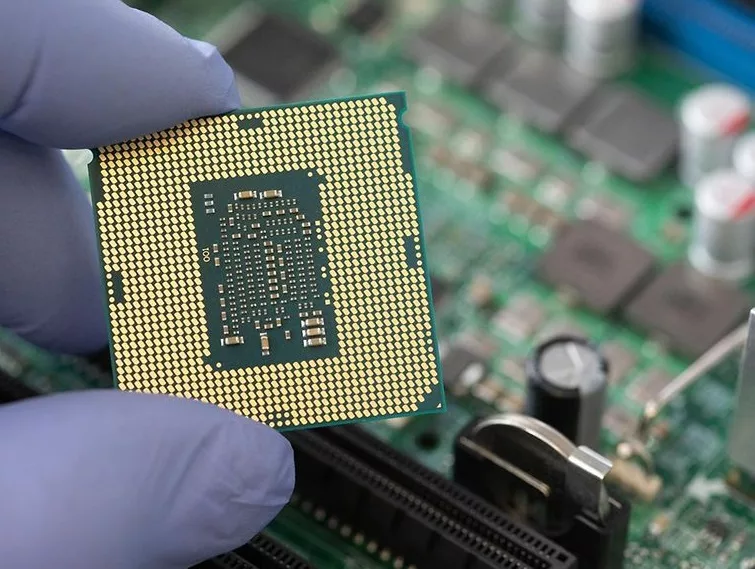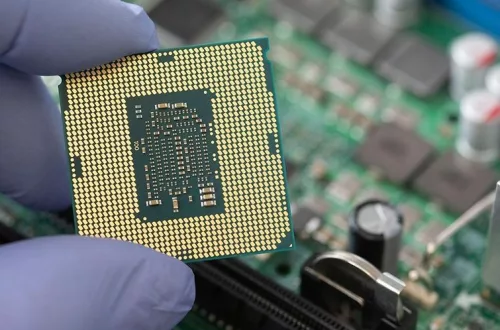-
Would Intel be converted into state-controlled enterprise?
The U.S. government is actively discussing converting up to $10.9 billion in CHIPS Act grants into Intel equity, which would give it a 10% stake and make it Intel’s largest shareholder. This move is not yet finalized, but negotiations are advanced, and Intel CEO Lip-Bu Tan has met with President Trump to discuss the deal.
The equity would come from restructuring milestone-based grants into direct ownership, giving the government voting power and long-term influence over Intel’s strategic direction. The U.S. may also target Intel Foundry specifically, which has been spun off as a semi-independent unit within Intel, to focus on leading-edge manufacturing.
Current Development
Intel stock initially rose nearly 15% on the news but has since shown volatility, reflecting investor uncertainty about the implications of government ownership. SoftBank has also invested $2 billion for a 2% stake, signaling private sector confidence in Intel’s turnaround.
This move is part of a broader trend of governments taking direct equity stakes in strategic tech sectors, similar to the Pentagon’s investment in MP Materials. It reflects a shift from subsidies to ownership, allowing the U.S. to shape Intel’s direction, especially in areas like AI, defense, and advanced chip manufacturing.
Legal and accounting questions remain, as CHIPS Act grants were originally designed as reimbursements, not equity. The final structure, valuation, and governance terms are still being negotiated, and no official confirmation has been issued by Intel or the White House.
Strategic Rationale
Intel is the only U.S.-headquartered advanced chipmaker capable of competing at leading-edge nodes (2nm and below). The investment is seen as a way to secure domestic chip production, reduce reliance on east Asia, and counter China’s tech rise.
Pros of Government Stake
National Security: Ensures U.S. control over critical infrastructure and chip supply chains.
Financial Stability: Provides Intel with long-term capital to fund fabs and R&D.
Industrial Policy Shift: Signals a move from subsidies to equity partnerships, reshaping tech investment norms.
Investor Confidence: May attract risk-averse investors seeking ‘safe’ tech plays backed by government.
Cons and Risks
Operational Constraints: Government ownership could limit Intel’s flexibility in global markets.
Geopolitical Tensions: Foreign nations may view Intel as a quasi-state entity, raising concerns over data security and neutrality.
Innovation Risk: Political mandates may interfere with R&D priorities or international collaborations.
Execution Risk: Unrealistic timelines or bureaucratic delays could hinder fab development.
Foreign Reactions and Concerns
China is likely to view Intel as a strategic U.S. asset, potentially restricting its market access, in the same philosophy that U.S. sees and treats Chinese firms. EU and Asian countries may reassess partnerships with Intel, fearing U.S. influence over technology, data security and supply chains. Global investors could recalibrate valuations based on geopolitical utility rather than traditional financial metrics.
Impact on Intel’s Future Business
Intel may become a ‘national champion’, prioritizing U.S. strategic goals over global competitiveness. Its foundry ambitions could be boosted by government contracts, especially in defense. However, Intel still lags behind in advanced node execution and faces stiff competition from TSMC and NVIDIA.
A New Tech Paradigm
The U.S. government’s stake in Intel marks a paradigm shift in how nations treat technology—as a strategic asset, not just a commercial product. This could lead to a bifurcation in the semiconductor industry: state-backed giants like Intel, aligned with national goals, and agile private firms like NVIDIA and AMD, focused on innovation and global markets. Intel’s future will depend on how well it balances government oversight with market competitiveness.
-
The EU–USA Tariff Deal: Sectoral Setback for Europe
Overview
On July 27, 2025, the European Union and the United States finalized a landmark trade agreement that capped U.S. tariffs on most EU goods at 15%, averting a previously threatened 30% escalation.
In return, the EU committed to significant energy purchases and investment flows into the U.S., while removing tariffs on select American exports. While the deal stabilizes transatlantic relations and offers strategic benefits, it also introduces sector-specific challenges for the EU economy.

Negative Impacts of the 2025 EU-USA Tariff Deal on EU Industry Sectors 1. Automotive Industry: A Competitive Blow
Tariff Impact: U.S. tariffs on EU automobiles remain at 15%, down from the threatened 30% but still above the pre-deal 10%
Negative Effects:
- German automakers like BMW, Mercedes-Benz, and Volkswagen face reduced competitiveness in the U.S. market.
- Electric vehicle exports, a growing EU strength, may lose ground to U.S. and Asian rivals due to higher landed costs.
- Supply chain disruptions could arise as EU-based parts suppliers face similar tariff burdens.
2. Steel and Aluminum: A Sector Under Siege
Tariff Impact: U.S. tariffs on EU steel and aluminum remain at 50%, unchanged from earlier hikes
Negative Effects:
- Export volumes are expected to decline sharply, especially for Italy, Germany, and Sweden, which are major producers.
- Overcapacity risks in the EU domestic market could lead to job losses and plant closures.
- Downstream industries (e.g., automotive, construction) may face higher input costs, reducing competitiveness.
3. Pharmaceuticals and Biotech: Asymmetrical Liberalization
Tariff Impact: EU eliminated tariffs on U.S. generic pharmaceuticals, but the U.S. imposed a 15% tariff on EU pharma exports
Negative Effects:
- EU drugmakers (especially in Ireland, Germany, and Belgium) face reduced margins in the U.S. market.
- Innovation funding could be squeezed as profits decline, potentially slowing R&D pipelines.
- Regulatory harmonization remains unresolved, adding non-tariff barriers to market access.
4. Semiconductors and High-Tech Manufacturing: Strategic Setback
Tariff Impact: EU removed tariffs on U.S. semiconductor tools and fabrication equipment; U.S. tariffs on EU tech goods remain at 15%
Negative Effects:
- European chipmakers (e.g., ASML, STMicroelectronics) face higher costs exporting to the U.S., while U.S. firms gain easier access to the EU.
- Technology sovereignty goals of the EU may be undermined by increased reliance on U.S. equipment and investment.
- R&D collaboration could become more one-sided, favoring U.S. firms.
5. Agriculture and Food Processing: Uneven Playing Field
Tariff Impact: EU removed tariffs on niche U.S. agricultural goods (e.g., almonds, whey), while U.S. tariffs on EU food exports rose to 15%
Negative Effects:
- French, Italian, and Spanish food exporters (e.g., wine, cheese, olive oil) face reduced demand in the U.S. due to higher prices.
- Small-scale producers are particularly vulnerable, lacking the scale to absorb tariff costs.
- Market share erosion in premium segments could be long-lasting.
6. Energy and Climate Transition: Strategic Trade-Off
Tariff Impact: EU committed to purchasing $750 billion in U.S. energy, primarily LNG
Negative Effects:
- European energy firms may lose domestic market share to U.S. LNG suppliers.
- Climate goals could be compromised if LNG imports delay investment in renewables.
- Infrastructure costs for LNG terminals and distribution may divert funds from green energy projects.
Conclusion: A Deal of Uneven Gains
While the EU–USA tariff deal prevents a full-blown trade war and secures strategic energy and investment flows, it imposes significant costs on key European industries. The asymmetry in tariff reductions—favoring U.S. exports in pharmaceuticals, semiconductors, and agriculture—raises concerns about long-term competitiveness and industrial sovereignty in the EU.
Questions:
1. Who made the decisions of accepting this kind deal on behalf of EU?
2. Will EU countries and industry sectors simply accept the result?
-
Who wins in the US-Vietnam trade deal?
On July 2, 2025, the United States and Vietnam finalized a new trade agreement involving tariffs. Under the deal, Vietnamese exports to the U.S. will face a 20% tariff, while U.S. goods entering Vietnam will be exempt from tariffs.
From a U.S. perspective, this appears to be a favorable outcome, particularly for former President Donald Trump, who has long emphasized trade deals that benefit American interests. Using 2024 trade figures as a reference:
- U.S. exports to Vietnam totaled $13.1 billion. Assuming Vietnam previously imposed an average tariff of 10%, the removal of this tariff could save U.S. exporters approximately $1.31 billion annually.
- U.S. imports from Vietnam amounted to $136.6 billion. A 20% tariff on these goods could generate $27.32 billion in revenue for the U.S. government.
Combined, these changes represent a potential economic shift of $28.63 billion, which supporters of the deal may view as a significant win for the U.S.
However, the broader implications are more nuanced.
While the tariff exemption may seem beneficial for U.S. exporters, Vietnam is not a major destination for U.S. goods globally. The impact on American businesses may be limited, especially considering existing non-tariff barriers that restrict market access.
Vietnam’s strategy, on the other hand, could be seen as a calculated move. By accepting higher tariffs on its exports, Vietnam may be positioning itself as a more attractive manufacturing hub for companies seeking alternatives to China. With Chinese goods facing tariffs as high as 55% in the U.S., Vietnam’s 20% rate could incentivize U.S. importers to shift sourcing to Vietnamese suppliers.
This could lead to increased foreign investment in Vietnam, particularly from Chinese firms looking to bypass U.S. tariffs by relocating production. The potential outcomes for Vietnam include:
- Growth in manufacturing and exports
- Job creation
- Real estate and infrastructure development
- Overall economic expansion
In this context, Vietnam may emerge as a strategic winner in the ongoing U.S.–China trade tensions.
As the agreement takes effect on July 9, the long-term consequences remain to be seen. Whether this deal marks a decisive victory for either side—or simply a tactical maneuver in a complex global trade landscape—will depend on how businesses and governments respond in the months ahead.









